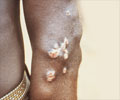A genome-wide study of infectious diseases, the first of its kind, promises new avenues for HIV treatment and vaccines.
The study, conducted by an international group of researchers through the Centre for HIV/AIDS Vaccine Immunology (CHAVI), has given way to a new understanding of why some people can suppress virus levels following HIV infection.“The clearer picture of host responses to the virus achieved through this examination of genomes could lead to improved HIV therapies and provides new targets for vaccine developers,” says Elias A. Zerhouni, M.D., director of the National Institutes of Health (NIH). CHAVI.
CHAVI’s host genetics team, led by David Goldstein, Ph.D., also of Duke University, identified three gene variants, two of which are linked to an infected person’s ability to control HIV viral load and a third that is implicated in disease progression to AIDS.
“CHAVI is designed to foster collaborative research to overcome roadblocks that have impeded HIV vaccine development. The insights into genetic factors influencing host control of HIV revealed by this work exemplify the power of such collective investigations,” says NIAID Director Anthony S. Fauci, M.D.
Recent genome-wide association studies have found that genetic markers are linked to an increased risk of diseases like diabetes, cancer and heart disease. The CHAVI investigators are the first to apply genome-wide association techniques to an infectious disease.
“People vary greatly in their vulnerability to HIV infection. In particular, there are striking and largely unexplained differences between individuals in the degree to which they are able to hold viral levels to a low set point in the period soon after infection,” says Barton Haynes, M.D., of Duke University, Durham, N.C.
Advertisement
The scientists applied the genome samples to gene chips dotted with more than 550,000 human gene variants, called single nucleotide polymorphisms or SNPs. The sweep of genomes found three SNPs that were strongly associated with either viral load set point or disease progression. The two variants associated with viral load can explain 15 percent of the total variation among all infected individuals, the scientists estimate.
Advertisement
HIV has many ways to defend itself from immune system efforts to eliminate it. One defence is the ability of an HIV gene, nef, to decrease the production of two related immune system proteins, HLA-A and HLA-B. Nef, scientists believe, is not able to similarly hamper the expression of HLA-C. If scientists could design a vaccine to enhance HLA-C-mediated immune responses, they might be able to hit HIV at a vulnerable point, says Dr. Goldstein. Although HLA-C had previously been suspected of contributing to HIV control, this genome-wide study is the first to confirm the association, he adds.
Science on the Science Express Web site publishes the research.
Source-ANI
LIN/C











